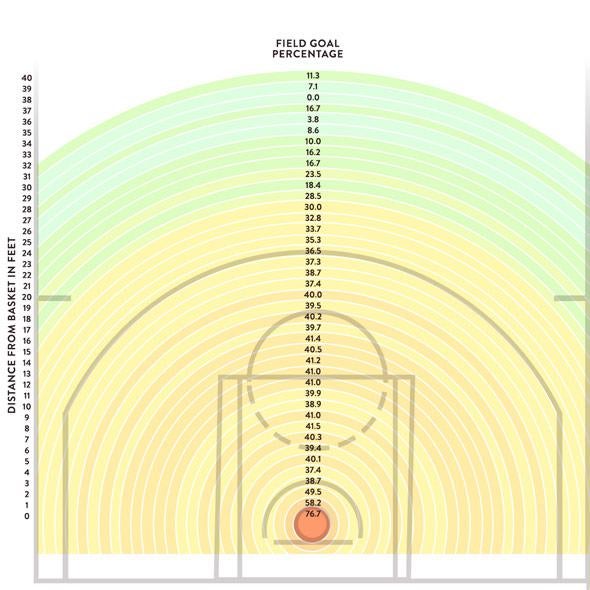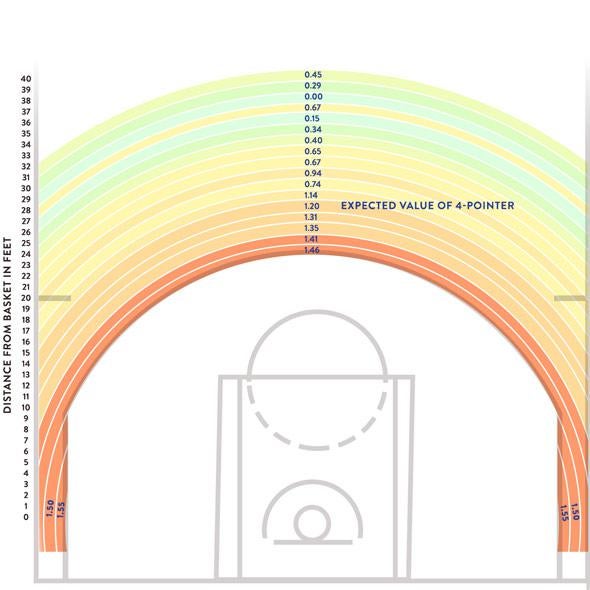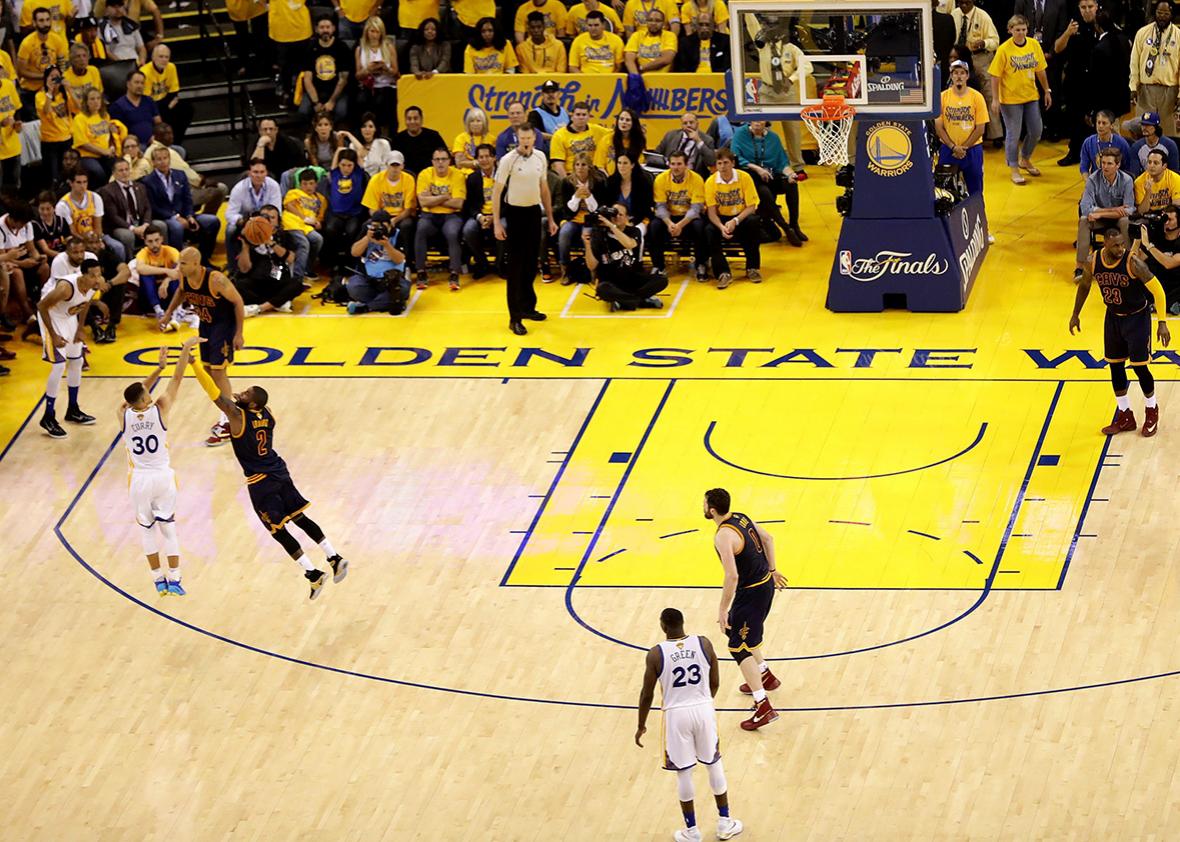The Cleveland Cavaliers just made history, becoming the first team ever to come back from down 3–1 to win the NBA Finals. That wasn’t the only record set in this year’s postseason. In Game 2 of the Eastern Conference semifinals, the Cavs made 25 3-pointers, the all-time record for any game in the playoffs or regular season. In Game 7 of the Western Conference semis, Klay Thompson made an all-time postseason record 11 3-pointers in leading the Warriors over the Thunder. In Game 4 of the finals, Golden State made 17 3-pointers in beating the Cavs, a record for the NBA’s championship series and the first time a team made more 3s than 2s in a finals game. Steph Curry set the record for most 3-point shots made (32) and attempted (80) in an NBA Finals. As a team, the Warriors made a total of 306 3-pointers this postseason, 66 more than the playoff record they’d set the season before. The Cavs, too, broke the 2015 Warriors’ not-so-long-standing record, making 258 3-pointers of their own.
These sorts of statistical anomalies are no longer all that anomalous. The 3-point shot has changed the NBA, and those changes have accelerated in the last few years as teams have come to understand the game’s simple mathematics. In 1979–80, when the league introduced the 3-pointer, teams averaged 2.8 attempts per game from beyond the arc. This year, NBA teams averaged 24.1 3-point attempts per contest. As SB Nation pointed out, Curry made more 3s this regular season—402—than any team made in a single season for the first 15 years of the 3-pointer’s existence.
The game has yet to reach equilibrium. The rate of 3-point attempts has increased each of the last six seasons, and there’s no reason to think that trend won’t continue. It’s possible that the NBA thinks this is perfectly fine—more 3s mean higher-scoring games, after all. If the league does believe 3-point shooting is getting out of control, it could always move the 3-point line back, as Mark Cuban has suggested. Or the NBA could go in the opposite direction and do something a bit more radical: introduce a 4-point shot.
“Please, no,” begged Warriors coach Steve Kerr when asked recently about the hypothetical 4-pointer, adding that it “sounds insane.” Reggie Miller, a prolific long-range shooter for his day, told the New Yorker that the 4-point shot would make the game a “laughingstock.” Portland point guard Damian Lillard, however, told Dan Patrick he would absolutely favor a 4-point-line, the current 3-pointer posing too modest a challenge for this generation of players: “You’ve got so many guys shooting it so easy!” Larry Bird, too, was sanguine about the idea; he likes the way the 3 has opened up the game and given chances to smaller players who’d be helpless in the mosh pit down low. “Maybe five or ten years down the road, fours are what everybody will be shooting. The game evolves,” he told the New Yorker.
The 4-pointer isn’t entirely in the realm of fantasy: ESPN reported a couple of years ago that the NBA had discussed the idea. If the league is going to take the concept seriously, there’s one obvious question it needs to answer: Where should they draw the 4-point line?
Byron Scott, the recently fired coach of the Los Angeles Lakers, suggested it should be “3 or 4 feet back” from the current 3-point distance of 22 feet in the corners and 23 feet, 9 inches everywhere else. Lillard thought 26 feet made sense. Patrick preferred 30.
Data can help. We grabbed the coordinates for every shot attempt in the NBA this season via Basketball Reference’s Play Index. (Though the shot distances in the Basketball Reference database are unofficial, they should be accurate enough for our purposes.) Here’s what those numbers look like:

You might be surprised—we were—to see that NBA players shoot roughly the same percentage (somewhere in the range of 37 to 42 percent) at every increment between 3 feet and 22 feet from the basket. More predictably, the number of shot attempts skyrockets at the 23-foot and 24-foot marks, where shooters position their toes just behind the 3-point line. There were 4,727 shots attempted this regular season at a distance of 22 feet from the basket. That figure more than doubled to 9,530 at 23 feet from the basket, then more than doubled again to 19,641 from 24 feet. There were more shots from 24 feet than any other spot on the court except right at the rim (21,711 shots) and 1 foot away from the basket (22,794 shots). Beyond 26 feet, the number of shots taken and the average shooting percentage decline sharply and consistently, as every NBA player aside from Stephen Curry loses his ability to knock down the longest of long-range shots. There were 6,665 shots taken from 26 feet, 2,238 from 27 feet, 747 from 28 feet, 277 from 29 feet, 152 from 30 feet, and just 68 from 31 feet.
Next, let’s look at the expected value of a field goal attempt from each spot on the court—the league’s average shooting percentage from a particular distance multiplied by two or three, depending on whether that shot is taken from inside or outside the arc. In other words, if a team shot from that position again and again, how many points per shot would they be likely to score?
Looking at the figure below, you can understand why teams place so much emphasis on the “corner 3”—the only shot that’s more valuable than a 22-foot 3-pointer is an attempt right at the rim. In addition, 3-point shots ranging from 23 feet to 29 feet away from the basket are all generally more valuable than any 2-point shot that’s taken farther than 3 feet from the basket. From a strict expected-value point of view, you ought to hang out by the rim or beyond the 3-point line.

Now let’s throw 4-pointers into the mix, to see what the expected value would look like with the 4-point line at various spots on the floor.

A 22-foot 4-pointer would obviously be ludicrous—at 1.55 points per shot, it would have a higher expected value than any other shot on the court. A 26-foot 4-point line like the one Damian Lillard proposed also seems too close. The expected value would be high enough, at 1.35 points per shot, that the game could converge to a sequence of dunks and 4s.
Around 30 feet would make more sense. Shots from that distance went in 28 out of 152 times in the 2015–16 season, a rate of 18.4 percent. Going for the quad would have an expected value of 0.74 points per shot, making it worth about the same as an average 4-footer or 21-footer.
A 30-foot 4-pointer likely wouldn’t distort the game too dramatically, then, though it might require making the court bigger. For most players, it would remain a poor percentage play. Stephen Curry took 45 shots this regular season from 30 feet and beyond and made 22 of them. The next most prolific very-long-range shooter: Damian Lillard with 16 attempts and two makes. Two! Though Steve Kerr says a 4-point line sounds insane, it would be truly crazy for him to reject a rule change that would give the Warriors such a huge advantage over the rest of the league.
Of course, if we made those shots worth 4 points instead of 3, there’d be more than 152 of them in a single season, players would practice them more, and the success rate would go up—yes, even outside Golden State. Players would adjust to the new game, just as they’ve adjusted to the 3-point shot. Any farther than 30 feet, though, and we’d expect to hit some fundamental physical limit to how accurate a shooter can be. The 4-pointer, if restricted to midcourt heaves, would probably stay a curiosity, basketball’s rouge.
Doesn’t all this seem arbitrary, though? If a 4, why not a 5, or a 6? And what about Reggie Miller’s complaint that the 3 has hurt the midrange game, reducing basketball to dunks, layups, and 3-pointers? He’s got a point: Of the 208,053 shots in our database, 58 percent were either taken within 2 feet of the basket or outside the 3-point line, precisely the strategy endorsed by the expected value table. If the 3 has put the midrange game on life support, the 4-pointer would pull the plug.
Here’s another thought experiment: What if we didn’t paint arbitrary lines on the court at all? What if the number of points a basket was worth was a continuous function of the distance from the hoop?
Stay with me, sports fans. If a shot 10 feet from the basket was worth 2.6 points compared to a layup’s 2, more people would take those 10-footers. So Reggie Miller’s happy. Each step back is worth something, each step forward costs you something; that’s a whole new layer of strategy. No longer would shots be concentrated around the basket and the 3-point arc; every spot on the court would be a shooting spot.
The continuous scoring function also fixes the worst thing about basketball: its endgame. In Game 7 of the NBA Finals, LeBron James hit a free throw to put the Cavs up 4 with just 10 seconds left to play. At this point, the Warriors had no choice but to try shooting a 3, then fouling to extend the game if they were lucky enough to make a long-distance shot. (They didn’t.) Wouldn’t it have been better if the Warriors had the option to get the ball to Curry at the 4.1-point line for a do-or-die heave? No more overtime nonsense: With scores measured to the nth decimal place, the chance of a tie would be just about nil. You take your best shot, the clock runs out, you win or you lose. It would be weird at first, no question. But unlike the way a close game ends now, it would be basketball.
